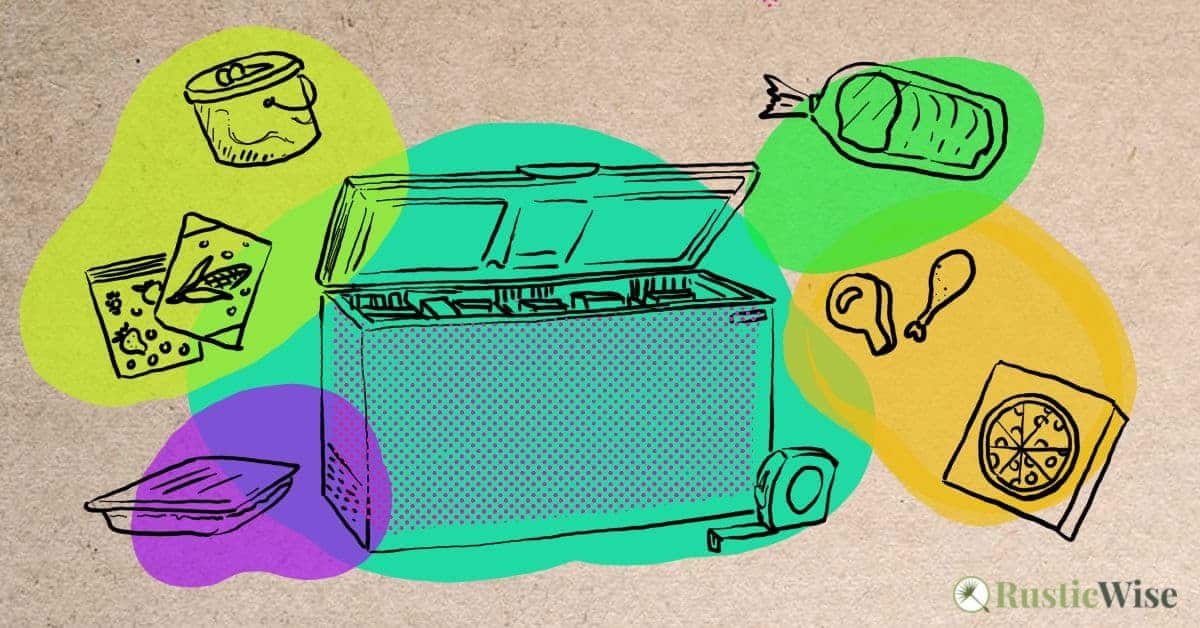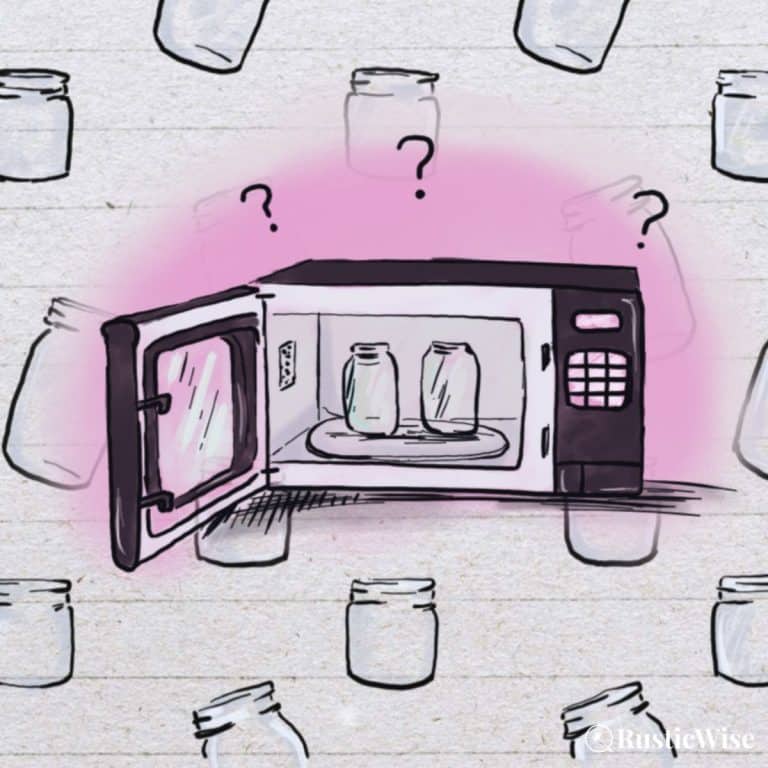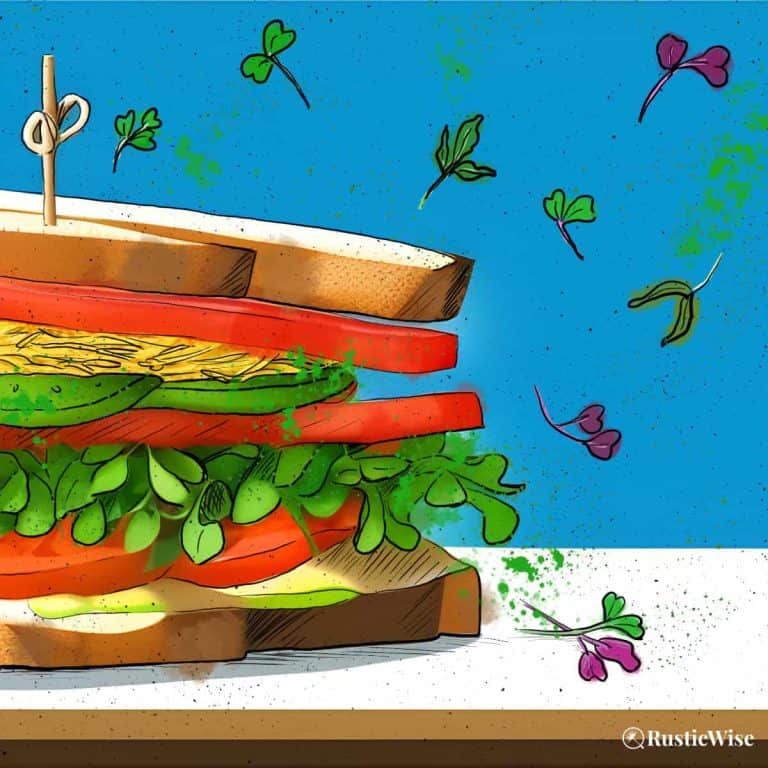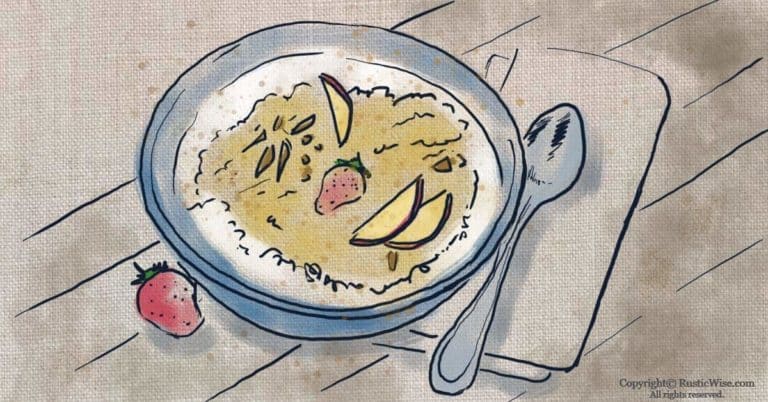How Much Will a Large Freezer Hold (17+ Cubic Feet)?
RusticWise is supported by its readers. When you purchase through links on our site, we may earn an affiliate commission. As an Amazon Associate, we earn from qualifying purchases. Thank You!
Are you looking to store more food in your home? If you’re wondering how much a large freezer will hold, the answer is about 595–735 pounds (270–333 kilograms) of food. This would accommodate roughly 11 to 14 people (based on the assumption that each person requires 1.5 cubic feet of food storage).
If you have the space and budget to accommodate a large freezer, you can now freeze whatever strikes your fancy. You can also get peace of mind knowing you have a bit of food security for your family (in case you don’t make it to the grocery store for a while). So, freeze fresh fruits and veggies from the garden. Buy meat in bulk. Stock up on frozen meals while they’re on sale.
If you’re looking to add a significant amount of extra food storage, a large freezer (between 17 to 21 cubic feet) may just be what you’re looking for.
Let’s examine how much food you can cram into a large freezer plus other things to consider before investing in a large home appliance.
Standard freezer sizes
Standalone deep freezers come in four basic sizes¹. Choosing a large freezer gives you plenty of space to freeze and stockpile a lot of food!
| Type | Freezer Capacity (cubic feet) |
|---|---|
| Compact | 3 to 5 cu. ft. |
| Small | 6 to 9 cu. ft. |
| Medium | 10 to 16 cu. ft. |
| Large | 17+ cu. ft. |
15 vs. 17 cubic feet freezer
Two popular freezer sizes are 15 cubic feet and 17 cubic feet. If you’re wondering whether to make the jump from a medium to large freezer, here are some storage differences. A 15 cubic feet freezer has a capacity of 525 pounds (238 kilograms), while a 17 cubic feet freezer can hold 595 pounds (270 kilograms) of food.
A 17 cubic foot freezer can hold 70 pounds (32 kilograms) more food.
17 vs. 21 cubic feet freezer
How big should you go? Let’s look at the holding capacity of each. A 17 cubic feet freezer holds about 595 pounds (270 kilograms) of food, while a 21 cubic feet freezer holds 735 pounds (333 kilograms) of food.
With a 21 cubic feet freezer, it can hold 140 pounds (64 kilograms) more food.
Of course, food storage capacity is just one consideration. You’ll also want to consider the physical dimensions of the freezer. We’ll cover freezer dimensions in more detail below.
Tip: Wondering how larger freezers affect overall size dimension? Keep in mind that generally, chest freezers add extra capacity in width (rather than depth or height). Upright freezers get bigger in height (rather than getting deeper or wider).
You might like
Frigidaire 68 Inch Freezer with 19.8 cu. ft. Capacity
- Dimensions: 73-11/16″ W x 29-9/16″ D x 31-3/4″ H
- 2 SpaceWise adjustable baskets help you organize items by categories or purchase date
- Includes 6 x casters
Found on Amazon
Check Current Price
Those in Canada and the UK should be taken to the product listing in your region.
How to calculate amount of freezer storage space required
Between 1.5 and 2.5 cubic feet of freezer storage space is required by the average person.
To calculate how much freezer space you’ll need, multiply the number of people in your household by 1.5–2.5 cubic feet.
Use this range of 1.5 to 2.5 as a guideline and adjust it according to your lifestyle and needs. For example, if you have more modest freezer needs, use 1.5 as a baseline. If you have small children, using 1.5 cubic feet of storage would make sense. If you like to stock up on freezer food, or have large, bulky or irregular-shaped items, then you’ll probably want to multiply by 2.5 cubic feet.
How much will a large freezer hold: different scenarios
We mentioned above that a general guideline is to multiply the number of people in your household by 1.5–2.5 cubic feet to determine how many cubic feet of freezer space you’ll need.
On average, a large (17 to 21 cubic feet) freezer is sufficient for a household with 11 to 14 people, depending on individual needs.
Here’s a chart outlining a rough guideline of freezer storage needs based on household composition.
| Number of People | Freezer Storage Needs Cubic Feet (Multiplied by 1.5) | Freezer Storage Needs Cubic Feet (Multiplied by 2.5) |
|---|---|---|
| 1 | 1.5 cu. ft. | 2.5 cu. ft. |
| 2 | 3 cu. ft. | 5 cu. ft. |
| 3 | 4.5 cu. ft. | 7.5 cu. ft. |
| 4 | 6 cu. ft. | 10 cu. ft. |
| 5 | 7.5 cu. ft. | 12.5 cu. ft. |
| 6 | 9 cu. ft. | 15 cu. ft. |
| 7 | 10.5 cu. ft. | 17.5 cu. ft. |
| 8 | 12 cu. ft. | 20 cu. ft. |
| 9 | 13.5 cu. ft. | 22.5 cu. ft. |
| 10 | 15 cu. ft. | 25 cu. ft. |
| 11 | 16.5 cu. ft. | 27.5 cu. ft. |
| 12 | 18 cu. ft. | 30 cu. ft. |
How many pounds of food can 1 cubic foot hold?
A general guideline is that 1 cubic foot holds approximately 35 pounds (16 kilograms) of food².
Keep in mind that packaging, type of food, and overall size play a large role in how much you can cram into 1 cubic foot. For example, 10 pounds of roast beef is more compact than 10 pounds of baked bread.
How much food fits in 1 cubic foot?
If all these numbers are confusing, let’s look at what you can comfortably fit into: 1 cubic foot (1 foot X 1 foot X 1 foot).
Based on my own calculations, you can fit about four standard loaves of bread in 1 cubic foot (the loaves fit 2 X 2).
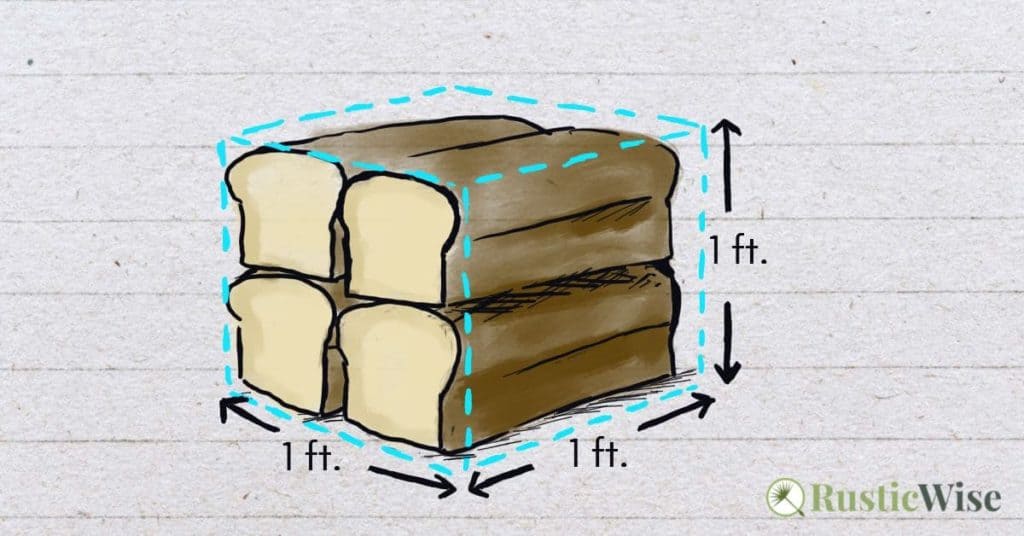
Freezer dimensions
Here’s a closer look at the size difference between chest freezers and upright freezers.
| Freezer Size and Capacity | Chest Freezer Size | Upright Freezer Size |
|---|---|---|
| Compact (3 to 5 cu. ft.) | 21–28″ W x 32–34″ H x 19–22″ D | 20–24″ W x 31–37″ H x 20–25″ D |
| Small (6 to 9 cu. ft.) | 29–38″ W x 32–34″ H x 22–27″ D | 21–25″ W x 55–60″ H x 22–26″ D |
| Medium (10 to 16 cu. ft.) | 54–65″ W x 33–36″ H x 24–28″ D | 23–30″ W x 60–73″ H x 27–30″ D |
| Large (17+ cu. ft.) | 72–84″ W x 31–34″ H x 27–32″ D | 27–33″ W x 64–76″ H x 29–30″ D |
Select a freezer that’s right for you and your household
There are many considerations to consider when deciding on the proper freezer size. While budget and freezer features are important to consider, let’s not forget about your basic household needs and preferences.
Lifestyle and household needs
Chances are if you’re looking to buy a large deep freezer, you’re likely planning on using it regularly for several reasons:
- Buy meat in bulk
- Cook large batches of food and sauces for easier meal prep
- Freeze fresh fruits and vegetables from the garden (or freeze store-bought varieties)
- Freeze leftovers to avoid food waste
- Stock up on bulk food items at the grocery store (hello frozen pizzas and ice cream!)
- Store extra loaves of bread
- Store homemade freezer jam
Take a moment to evaluate your household needs when deciding on the right freezer size. If you think that a large freezer has a bit too much storage space, consider buying a medium or small freezer instead.
Freezer style
There are two main types of standalone freezers: upright freezer or chest freezer (aka box freezer).
An upright model has similar dimension as a standard refrigerator with a door that swings open, side-to-side. With adjustable shelving, an upright freezer makes it easier to keep your food organized and have different freezer sections. If you’re short on floor space, the good news is that upright models require less floor space and provide easier access to food.
The downside to upright freezers is they hold less food than chest freezers. According to Consumer Reports3, the shelves and bins of upright freezers use roughly 20 percent more space than those in chest freezers, leaving you with less available cubic footage.
Chest freezers have doors that swing up when opened. They have a greater storage capacity than upright models and hold more food per cubic foot. Food stays cooler in a chest freezer. Many people who like to stock up on meat choose chest deep freezers. In case of a power outage, food stored in a chest freezer can typically stay cool for a longer time than an upright freezer. New (or used) chest freezers generally cost less than upright freezers.
The downside to chest freezers is they take up more floor space. It’s also more difficult to reach foods on the bottom. Many people end up with a bottom layer of food covered in freezer burn. To avoid this, try to use up food in a timely manner. Consider buying freezer bins or wire baskets to keep frozen foods organized and use up the oldest foods first.
Available space
How much extra space you have at home largely determines the size and type of freezer you buy: upright vs. chest freezer. Sometimes, you can keep your freezer in the garage.
Remember to allow for at least 1 inch of space (preferably more) between the back of the freezer and the nearest wall, plus several inches of clearance all around. This allows for sufficient airflow around the appliance, which keeps it running in optimal condition.
An ideal place to put a deep freezer is in a cool, dry room away from windows and sunlight, and other heat sources.
You might like
Wire Freezer Storage Basket Organizers, 4-Pack
- Dimensions: 11″ L x 10″ W x 5.5″ H
- Durable construction: PE-coated and rustproof
- Open design and built-in handles for portability
Found on Amazon
Check Current Price
Those in Canada and the UK should be taken to the product listing in your region.
Why getting the right freezer size for your household matters
When choosing the right freezer size, aim for one that’s not too big, not too small, but just right.
When you buy a freezer that’s the proper size for your household needs, this helps to optimize freezer efficiency and ensure food safety.
Freezers that are packed to the brim have poor air circulation. Insufficient air movement causes some foods to stay cold, while others get too warm; this leads to potential food safety and temperature control issues. When your freezer is too full, the freezer compressor works harder (which eventually leads to breakdown). Aim to leave some room at the top and sides of the freezer compartment for adequate airflow.
Freezers that sit mostly empty are inefficient. While it’s fine to leave some empty freezer space, too much space requires a lot of energy to keep cool round-the-clock. (And who doesn’t want to conserve energy and save a bit of money on monthly bills?)
If you want to fill up an empty freezer, use this frozen water trick.
Fill clean milk jugs or other juice containers with water (remember to leave space at the top for expansion). Ziploc bags filled with water or ice cubes will also work. When your freezer is adequately full, it prevents temperature fluctuations from occurring every time you open the door.
Tip: Aim for a freezer that’s around 70-85 percent full4. This allows proper air circulation while also optimizing energy efficiency.
How much meat can you store in a large freezer (17+ cubic feet)?
Buying meat in bulk is one of the many benefits of having a larger freezer. With a short shelf life and fluctuating prices, it makes sense to buy meat in bulk and stock up.
If you’re wondering how much frozen meat fits in a large (17 to 21 cubic feet) freezer, it’s approximately 35–40 pounds (16–18 kilograms) of meat per each cubic foot⁵. This means you could fit about 595–735 pounds (270–333 kilograms) of meat, or roughly a whole cow, (when assuming 35 pounds per cubic foot).
If you want to have a bit of extra space for other foods along with a whole beef, aim for a 21 cubic foot freezer.
The takeaway: how much will a large freezer hold?
A large freezer between 17 and 21 cubic feet will hold approximately 595–735 pounds (270–333 kilograms) of food. and may be enough for 11 to 14 people. In terms of meat storage, a large freezer holds an entire cow. When deciding on a freezer, remember to consider your lifestyle needs and whether an upright model vs. chest freezer is right for you.
If you have space for a large freezer, it should provide you with plenty of food storage at home.
Related questions
What’s the ideal temperature for a deep freezer?
The U.S. Food & Drug Administration (FDA)⁶ recommends keeping your freezer temperature at 0 degrees Fahrenheit (-18 degrees Celsius) or lower. Foods properly packaged and stored at this temperature can, in theory, last indefinitely. However, most frozen foods may deteriorate in quality and taste (and likely develop freezer burn over time). So enjoy your frozen foods sooner rather than later!
How big of a freezer do you need for 100 pounds of meat?
100 pounds (45 kilograms) should fit in a 3 cubic foot freezer. I base this on the assumption that each cubic foot holds approximately 35 pounds (16 kilograms) of frozen meat.
Remember to account for packaging size and shape to provide a more accurate estimate.
How often should you defrost a freezer?
A general guideline is to defrost your freezer at least once a year, or when the ice becomes 1/4-inch thick. Over time, ice develops along the freezer walls because of air moisture buildup. Defrosting your freezer is important as it helps to optimize efficiency. When you have a thick layer of ice, your freezer works harder to keep food cool. This leads to energy wastage, and higher bills!
How big is a standard freezer?
There’s not really a definitive “standard” size of freezer. But just to give you a rough idea, a standard refrigerator freezer (with a top-freezer) has a storage capacity of around 4–5 cubic feet.
The most popular standalone freezer sizes are: 3.5, 5, 7, and 10 cubic feet.
Keep in mind that people who live on farms and rural areas have differing needs than city dwellers. Space constraints are the biggest issue for many people in the city, which is why compact or small freezers are more common in urban areas. My husband grew up on a farm where they had two large freezer chests (18+ cubic feet), side-by-side.
How to measure and calculate freezer capacity
We measure freezers in cubic feet, which measures volume. (Imagine a cube with sides that measure 1 foot each.)
To calculate freezer capacity, measure the interior of your freezer’s length, width and height. (Convert your measurement to feet if you measured in inches or centimeters.)
Finally, multiply the three numbers together (in feet): Length X Width X Height
The answer gives you a rough idea of your freezer’s capacity.
Check out related posts:
👉 How Much Will a 1-5 Cubic Foot (Compact) Freezer Hold?
👉 How Much Will a Small Freezer Hold (6 to 9 Cubic Feet)?
👉 How Much Will a Medium Freezer Hold (10 to 16 Cubic Feet)?

References
- Maytag, Guide to Freezer Sizes and Dimensions, https://www.maytag.com/blog/kitchen/freezer-sizes-and-dimensions-guide.html. Accessed October 2021.
- Lowe’s, Freezer Buying Guide, https://www.lowes.com/n/buying-guide/freezer-buying-guide . Accessed October 2021.
- Consumer Reports, Freezer Buying Guide, https://www.consumerreports.org/cro/freezers/buying-guide/index.htm . Accessed October 2021.
- Sears Home Services, 5 Most Common Freezer Problems and Solutions, https://www.searshomeservices.com/blog/5-most-common-freezer-problems-and-solutions. Accessed October 2021.
- Sparacio, Micah (23 March 2020). “ How Much Beef Can I Fit in a Freezer? “, Cove Creek Farm. Accessed October 2021.
- U.S. Food & Drug Administration (FDA), Are You Storing Food Safely?, https://www.fda.gov/consumers/consumer-updates/are-you-storing-food-safely. Accessed October 2021.

Author: Theresa Tesolin
Theresa is co-founder of RusticWise. She helps people unleash their inner DIY spirit by encouraging them to get dirty and make or grow something from scratch.

